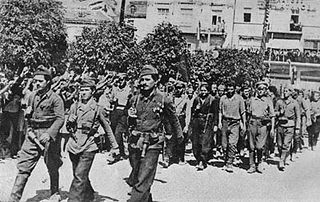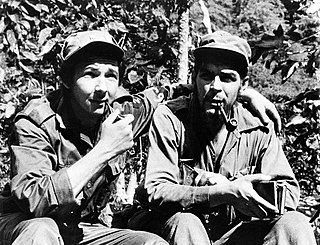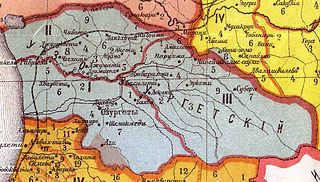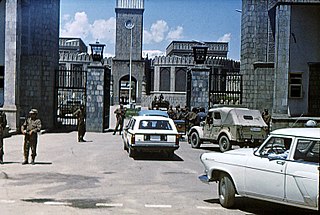 W
WA communist revolution is a proletarian revolution often, but not necessarily, inspired by the ideas of Marxism that aims to replace capitalism with communism. Depending on the type of government, socialism can be used as an intermediate stage to Communism. The idea that a proletarian revolution is needed is a cornerstone of Marxism; Marxists believe that the workers of the world must unite and free themselves from capitalist oppression to create a world run by and for the working class. Thus, in the Marxist view, proletarian revolutions need to happen in countries all over the world.
 W
WThe August Revolution, also known as the August General Uprising, was a revolution launched by Ho Chi Minh's Việt Minh against French and the Japanese Empire colonial rule in Vietnam, on August 14, 1945.
 W
WThis is a select bibliography of post World War II English language books and journal articles about the Revolutionary and Civil War era of Russian (Soviet) history. The sections "General Surveys" and "Biographies" contain books; other sections contain both books and journal articles. Book entries may have references to reviews published in English language academic journals or major newspapers when these could be considered helpful.
 W
WThe 1944 Bulgarian coup d'état, also known as the 9 September coup d'état, was the forcible change of the government of Kingdom of Bulgaria carried out on the eve of 9 September 1944. In Communist Bulgaria it was called People's Uprising of 9 September – on the grounds of the broad unrest, and Socialist Revolution – as it was a turning point politically and the beginning of radical reforms towards socialism.
 W
WThe Cambodian Civil War was a civil war in Cambodia fought between the forces of the Communist Party of Kampuchea against the government forces of the Kingdom of Cambodia and, after October 1970, the Khmer Republic, which had succeeded the kingdom.
 W
WThe Chinese Communist Revolution, known in mainland China as the War of Liberation, was the conflict, led by the Communist Party of China and Chairman Mao Zedong, that resulted in the proclamation of the People's Republic of China, on 1 October 1949. The revolution began in 1946 after the Second Sino-Japanese War (1937–45) and was the second part of the Chinese Civil War (1945–49).
 W
WThe Cuban Revolution was an armed revolt conducted by Fidel Castro's revolutionary 26th of July Movement and its allies against the military dictatorship of Cuban President Fulgencio Batista. The revolution began in July 1953, and continued sporadically until the rebels finally ousted Batista on 31 December 1958, replacing his government. 26 July 1953 is celebrated in Cuba as the Day of the Revolution . The 26th of July Movement later reformed along Marxist-Leninist lines, becoming the Communist Party of Cuba in October 1965.
 W
WIn late February 1948, the Communist Party of Czechoslovakia, with Soviet backing, assumed undisputed control over the government of Czechoslovakia, marking the onset of four decades of communist rule in the country.
 W
WThe Fall of Saigon, also known as the Liberation of Saigon, was the capture of Saigon, the capital of South Vietnam, by the People's Army of Vietnam (PAVN) and the Viet Cong on 30 April 1975. The event marked the end of the Vietnam War and the start of a transition period to the formal reunification of Vietnam into the Socialist Republic of Vietnam.
 W
WThe German Revolution or November Revolution was a civil conflict in the German Empire at the end of the First World War that resulted in the replacement of the German federal constitutional monarchy with a democratic parliamentary republic that later became known as the Weimar Republic. The revolutionary period lasted from November 1918 until the adoption in August 1919 of the Weimar Constitution.
 W
WThe Gurian Republic refers to an insurrection and protest movement that took place in the western Georgian region of Guria against the Russian Empire between 1902 and 1906. This rose from a revolt over land grazing rights in 1902. Several issues over the previous decades affecting the peasant population including taxation, land ownership and economic factors also factored into the start of the insurrection. It gained further traction through the efforts of Georgian social democrats, despite some reservations within their party over supporting a peasant movement, and grew further during the 1905 Russian Revolution.
 W
WThe Laotian Civil War (1959–1975) was a civil war in Laos fought between the Communist Pathet Lao and the Royal Lao Government from 23 May 1959 to 2 December 1975. It is associated with the Cambodian Civil War and the Vietnam War, with both sides receiving heavy external support in a proxy war between the global Cold War superpowers. It is called the Secret War among the CIA Special Activities Center and Hmong veterans of the conflict.
 W
WThe left-wing uprisings against the Bolsheviks, known in anarchist literature as the Third Russian Revolution, were a series of rebellions, uprisings, and revolts against the Bolsheviks by oppositional left-wing organizations and groups that started soon after the October Revolution, continued through the years of the Russian Civil War, and lasted into the first years of Bolshevik rule of the Soviet Union. They were led or supported by left-wing groups such as some factions of the Socialist Revolutionary Party, Left Socialist-Revolutionaries, Mensheviks, and anarchists. Generally, the uprisings began in 1918 because of the Bolshevik assault on soviet democracy, the signing of the Treaty of Brest-Litovsk, and opposition to Bolshevik socioeconomic policy. The Bolsheviks grew increasingly hard-line during the decisive and brutal years following the October Revolution. These rebellions and insurrections occurred mostly during and after the Russian Civil War, until around 1924, though there did exist various small-scale insurgencies until World War II.
 W
WThe Mexican Revolution was a major revolution, including a sequence of armed struggles, lasting roughly from 1910 to 1920, that transformed Mexican culture and government. Its outbreak in 1910 resulted from the increasing unpopularity of the 31-year-long regime of Porfirio Díaz and the regime's failure to find a controlled solution to presidential succession. This resulted in a power struggle among competing elites, which created the opportunity for agrarian insurrection. Wealthy landowner Francisco I. Madero challenged Díaz in the 1910 presidential election, and following the rigged results, revolted under the Plan of San Luis Potosí.
 W
WThe Mongolian Revolution of 1921 was a military and political event by which Mongolian revolutionaries, with the assistance of the Soviet Red Army, expelled Russian White Guards from the country, and founded the Mongolian People's Republic in 1924. Although nominally independent, the Mongolian People's Republic was a satellite state of the Soviet Union until a third Mongolian revolution in January 1990. The revolution also ended Chinese Beiyang government's occupation of Mongolia, which had existed since 1919. The official Mongolian name of the revolution is "People's Revolution of 1921" or simply "People's Revolution".
 W
WThe Nepalese Civil War was an armed conflict in Nepal fought between the Communist Party of Nepal (Maoist) (CPN-M) and the Government of Nepal from 1996 to 2006. The conflict period is known as the Saśastra Dvandvakāla in Nepal.
 W
WThe Nicaraguan Revolution encompassed the rising opposition to the Somoza dictatorship in the 1960s and 1970s, the violent campaign led by the Sandinista National Liberation Front (FSLN) to oust the dictatorship in 1978–79, the subsequent efforts of the FSLN to govern Nicaragua from 1979 to 1990, and the Contra War, which was waged between the FSLN-led government of Nicaragua and the United States-backed Contras from 1981–1990. The revolution marked a significant period in the history of Nicaragua and revealed the country as one of the major proxy war battlegrounds of the Cold War, attracting much international attention.
 W
WThe October Revolution, also known as the Great October Socialist Revolution, as the official term in the Soviet Union, the Bolshevik Coup, the Bolshevik Revolution, the October Uprising, the October Coup or Red October, was a revolution in Russia led by the Bolshevik Party of Vladimir Lenin that was instrumental in the larger Russian Revolution of 1917–1923. It took place through an armed insurrection in Petrograd on 25 October 1917. It was the precipitating event of the Russian Civil War.
 W
WThe Paris Commune was a radical socialist, anti-religious, and revolutionary government that ruled Paris from 18 March to 28 May 1871. The Franco-Prussian War had led to the capture of Emperor Napoleon III in September 1870, the collapse of the Second French Empire, and the beginning of the Third Republic. Because Paris was under siege for four months, the Third Republic moved its capital to Tours. A hotbed of working-class radicalism, Paris was primarily defended during this time by the radical troops of the National Guard rather than regular Army troops. Paris surrendered to the Prussians on 28 January 1871, and in February Adolphe Thiers, the new chief executive of the French national government, signed an armistice with Prussia that disarmed the Army but not the National Guard.
 W
WThe People's Revolutionary Government (PRG) was proclaimed on 13 March 1979 after the New Jewel Movement overthrew the government of Grenada in a revolution. The government suspended the constitution and ruled by decree until a factional conflict broke out, culminating in an invasion by the United States on 25 October 1983.
 W
WThere was a period of revolutions and interventions in Hungary between 1918 and 1920. The First Hungarian Republic was founded by Mihály Károlyi during the Aster Revolution in 1918. In March 1919, the republic was overturned by another revolution, and the Hungarian Soviet Republic was created. The unresolved conflicts led to wars between Hungary and its neighbor states in 1919. The Hungarian Soviet Republic ceased to exist after the Romanian occupation. The Treaty of Trianon in Versailles chilled the conflicts and beneficiaries for this event were Romania, the newly formed states of Czechoslovakia, and the Kingdom of Serbs, Croats and Slovenes.
 W
WThe Revolutions of 1917–1923 was a revolutionary wave that included political unrest and revolts around the world inspired by the success of the Russian Revolution and the disorder created by the aftermath of World War I. The uprisings were mainly socialist or anti-colonial in nature. Many attempted socialist revolts failed to have a long-term impact.
 W
WThe Russian Revolution was a period of political and social revolution across the territory of the Russian Empire, commencing with the abolition of the monarchy in 1917 and concluding in 1923 with the Bolshevik establishment of the Soviet Union at the end of the Civil War.
 W
WThe Saur Revolution, also romanized Sowr Revolution, and alternatively called the April Revolution or April Coup, was a coup d'état led by the Soviet-backed People's Democratic Party of Afghanistan (PDPA) against the rule of Afghan President Mohammed Daoud Khan on 27–28 April 1978. Daoud Khan and most of his family were killed at the presidential palace. The revolution resulted in the creation of a government with Nur Muhammad Taraki as President, and was the precursor to the 1979 intervention by the Soviets and the 1979–1989 Soviet–Afghan War against the Mujahideen.
 W
WWorld War II military operations in Yugoslavia began on 6 April 1941, when the Kingdom of Yugoslavia was swiftly conquered by Axis forces and partitioned between Germany, Italy, Hungary, Bulgaria and client regimes. Subsequently, a guerrilla liberation war was fought against the Axis occupying forces and their locally established puppet regimes, including the fascist Independent State of Croatia and the Government of National Salvation in the German-occupied territory of Serbia, by the communist-led republican Yugoslav Partisans. Simultaneously, a multi-side civil war was waged between the Yugoslav communist Partisans, the Serbian royalist Chetniks, the Croatian fascist Ustashe and Home Guard, Serbian Volunteer Corps and State Guard, as well as Slovene Home Guard troops.
 W
WWorld War II in Yugoslav Macedonia started with the Axis invasion of Yugoslavia in April 1941. Under the pressure of the Yugoslav Partisan movement, part of the Macedonian communists began in October 1941 a political and military campaign to resist the occupation of Vardar Macedonia. Officially, the area was called then Vardar Banovina, because the very name Macedonia was prohibited in the Kingdom of Yugoslavia. It was occupied mostly by Bulgarian, but also by German, Italian, and Albanian forces.